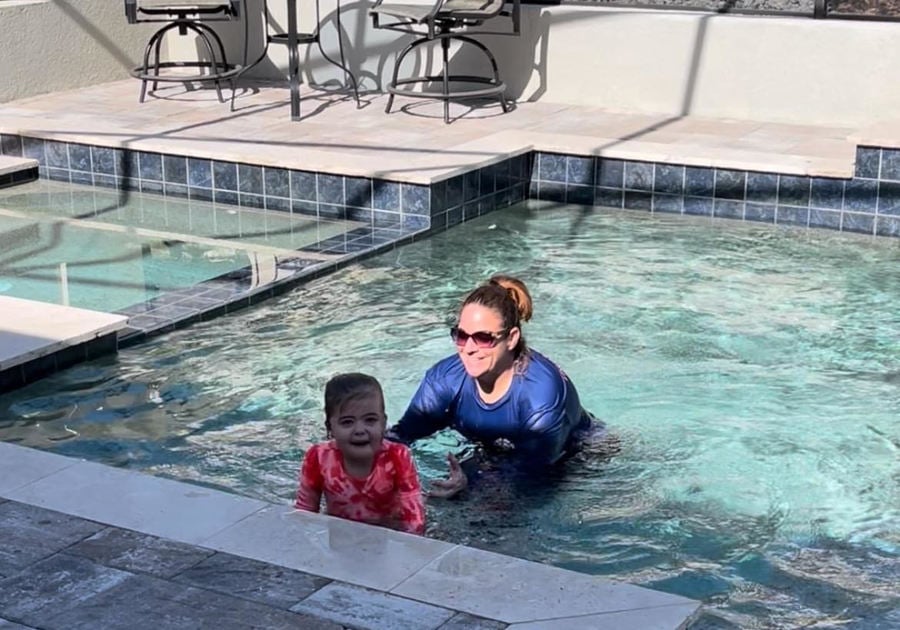The Sunshine State is famous for its endless summer weather and beautiful beaches and lakes. That sunny weather also offers plenty of opportunities for pool time. We’re coming upon summer break soon. The kids are out of school, they have more time available for fun, and it’s the hottest time of year. It’s no surprise that summertime brings even more swim time!
While pools can offer hours of entertainment, it’s important to remember how to keep your kiddos safe in the water. The fact is that drowning is the leading cause of preventable deaths among children between the ages of one and four, and the second leading cause among children ages one to 14 (per the Center for Disease Control). Even for those children who survive drowning incidents, severe consequences can occur, including lasting neurological issues.
Parents want their children to have fun and remain safe in the water. Often parents might think that purchasing a flotation device for their children to use in the water will keep them safe. But there are hidden dangers to using floating devices in the pool. These floaties often keep children in an upright position while in the water, not truly mimicking a swimming posture. While they do provide some level of buoyancy in the water, they also provide a false sense of security when children are in the water. They can make young children think that swimming is easy and that the water is not dangerous. They may then think that they can get into the pool without floatation devices.
Children can drown in as little as 20 seconds. That doesn’t leave much time to get them help in the case of an emergency. The best course of action is to teach them (and yourself) water safety tips.
Here are some steps you should take to prevent children from drowning.
1. Actively Supervise Children Around Water
Children who are playing in or around water should be supervised at all times by adults. Supervising adults should watch children at all times and avoid distractions so that they are prepared to act in case of an emergency.
2. Enclose Pools
Most states have laws mandating pool enclosures. For example, under § 515.29, Fla. Stat. (2022), Florida requires pools to be enclosed by fences that are at least four feet tall. The fence must also have a locking gate and must not have any gaps large enough for a child to crawl through. This law is meant to make it more difficult for children to climb over or through a fence to gain access to the water. Swimming pools and spas must also have covers over them to keep children out during the winter months.
3. Install Alarms
Alarms can be installed on doors and windows that open into a pool area as an added precaution.
4. Check Before You Leave the Pool
When you leave the pool area, double-check to ensure the gate is closed and locked. Take any toys you bring to the pool with you, so that kids don’t attempt to gain entry later to get their toys.
5. Check the Pool First
If you can’t find your child in your home, check the pool first before searching throughout your house. This can greatly increase the chances that your child will survive if they have had a swimming pool accident.
6. Learn How to Turn Off Your Pool Pump
Learn how to turn off your pool pump. The suction can trap a child’s or adult’s swimming suit or hair and prevent them from swimming to the surface for air. Quick access - and the knowledge how - to turn it off is a must.
7. Make Sure your Children Learn to Swim
Another way to ensure their safety is to make sure your children learn to swim by taking swimming lessons. Baby Otter Swim School® of SW Orlando specializes in teaching very young children how to swim to help prevent drowning accidents. Baby Otter Swim School® of SW Orlando is a traveling swim school featuring one-on-one learning in five days time. They offer multiple instruction levels for people of all ages from nine months up.
Baby Otter Swim School® utilizes the Turn, Kick, Reach method to teach very young children how to react appropriately if they fall into water that is too deep for them. The method is very simple and can usually be taught in just five lessons, which is ideal for parents with busy schedules:
- First, the child is trained to turn toward the place where they fell into the water.
- They then kick their feet to propel them forward and toward the side of the pool or body of water.
- Finally, the child reaches forward toward the side of the pool and holds on until help arrives.
Parents can participate in the lessons to build trust and to ensure the best results for their child. This can prevent many accidental drowning incidents and can ensure the best possible outcomes for families in Florida and across the nation.
This article is sponsored by Baby Otter Swim School of Southwest Orlando. They offer private one-on-one swim programs to teach your kiddos from nine months up (and grown ups, too!) how to swim in just five days. Local locations are in Haines City and Davenport, Florida. For more information call (407) 906-0371 or visit https://www.babyotterswimschool.com/franchise/sw-orlando/.
Amanda Swank is the publisher of Macaroni KID Winter Haven - Davenport, Florida.



